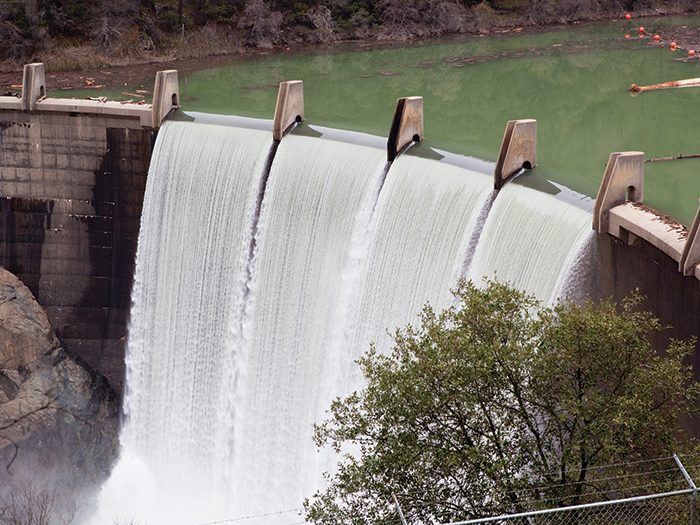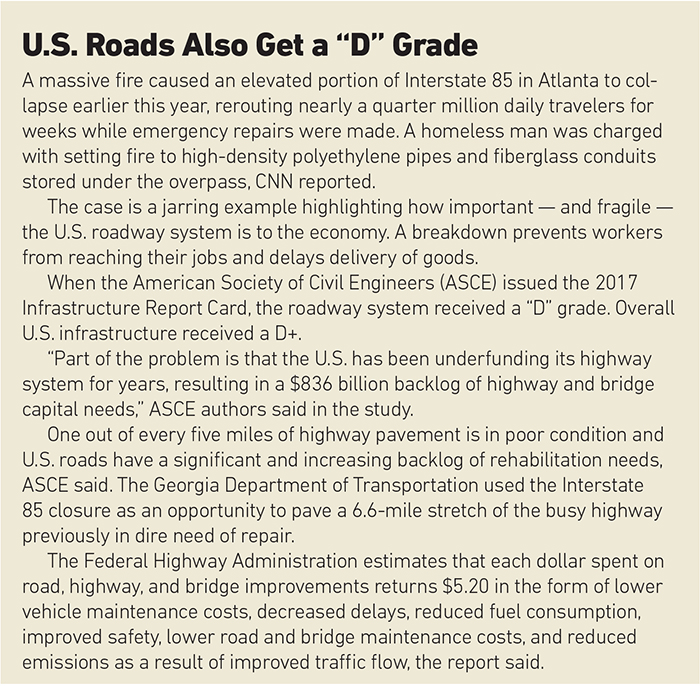Flood Risk
Protecting Dam Breach Inundation Zones

After a five-year drought, the rains finally returned to California this winter. Lake Oroville, which was formed in 1967 at the foot of the Sierra Mountains by the nation’s tallest dam, began to refill.
An atmospheric river, colloquially known as a “Pineapple Express,” continued dropping water at such a pace that it replenished the reservoir and then some. The swollen lake forced the excess water onto an emergency spillway alongside the Oroville Dam for the first time in half a century.
The spillway cement crumbled and sent a cascade of water down the mountainside. Engineers feared the erosion compromised not only the spillway but also the 770-foot-tall earthen dam.
An emergency evacuation was hastily ordered and nearly 190,000 residents were forced to flee their homes. Traffic clogged roads. Fortunately, no life was lost and water levels eventually receded.
For many, this crisis is a wake-up call for renewed assessment of the aging infrastructure of the U.S. dam system and the emergency response plans drawn to prevent loss of life in the event of a failure.
Dams Exceeding Effective Dates
Nearly all of the 700 dams managed by the U.S. Army Corps of Engineers are more than 30 years old. More than half have reached or exceeded the 50-year service lives for which they were designed. Oroville Dam turns 50 next year.
Tim McCarty is a risk control manager at Trident Public Risk Solutions, which insures a wide range of municipalities including those in close proximity to a dam. His statistics on the aging dam system in the U.S. are alarming.
“The average age of our dams nationwide is 56 years,” he said. “And the average age of a failed dam is 62 years. “So we’re kind of reaching that point where we’re starting to have some very old infrastructure and if it’s not properly maintained we may see repeats of this type of an incidence,” McCarty said.
The Federal Emergency Management Agency says dam failures are a “low probability but high consequence” event. Due to the rarity, many people who live downstream in “dam breach inundation zones” are completely unaware of the potential hazard. But they are, in fact, at the mercy of the dam’s ongoing health.
“The only time the concept is front and center is when water is rushing over the dam,” said John Dickson, president of NFS Edge Insurance Agency.
“I worry constantly that that’s a total disservice to the American people. We need to have the conversation when the sun is shining.”
Dams are a vital part of the U.S. infrastructure. They provide flood protection, water supply, hydropower, irrigation and recreation. But all it takes is one busy muskrat to compromise a dam’s integrity and cause a breach.
The operators of the Oroville Dam were advised in 2005 to shore up the spillway with concrete. For a dozen years, the expensive recommendation was tabled. The reasoning was the emergency spillway was never used because the lake water never rose high enough.
When it finally did, the emergency response — mass evacuations and helicopters dropping dirt and boulders to fortify the dam — averted a catastrophe. But it was an expense way beyond the cost of maintenance. And some never received notice of the evacution, according to the Associated Press.
Dams Fail Quickly
Every four years, the American Society of Civil Engineers issues a “Report Card for America’s Infrastructure.” Bridges, roads, and tunnel systems are evaluated on capacity, condition, funding, future need, operation and maintenance, public safety, resilience and innovation.
Dams received a “D” grade in the 2017 report released in March. The Army Corps of Engineers estimated it would take $45 billion to fix aging, yet critical, high-hazard potential dams.
It’s not only dams that are in need of repairs. The U.S. received a “D+” overall on 16 areas of infrastructure. To raise the overall infrastructure grade and maintain our global competitiveness, Congress and the states must invest an additional $206 billion, according to the report.
“The average age of our dams nationwide is 56 years. And the average age of a failed dam is 62 years.” —Tim McCarty, risk control manager, Trident Public Risk Solutions
State agencies regulate most of the nation’s 90,000 dams. Unlike bridges and roads, the U.S. government may inspect the dams but it doesn’t maintain most of them. More than 65 percent are privately owned and those owners may lack the money needed for adequate maintenance.
Experts say dam owners need to know how their structures are aging and prepare for the repairs that need to be done. They also need to develop a time line for replacement and know how to respond if the dam fails.
It is most important to conduct regular inspections and deal with what seem to be minor issues immediately.
“Many people just think you build a dam and it’s just there and fades into the background,” McCarty said.
“But it really is an active system that has to be maintained — just like a road or a bridge.”
Gritzo speaks with clients about opportunities to retrofit facilities and fill in the weak spots. More often than not, an engineer looks at an aging structure and weighs when it is best for a new build. The cost of that is often too challenging, Gritzo said.
Unlike a river flooding over its banks, a dam breach may occur with little to no warning.
An emergency response plan is needed to lay out the time required to get mitigation efforts in place and who is responsible for completing each task.
Conduct Hazard Assessments
“With a dam breach, when it fails, it fails quickly, the water comes out quickly and there’s a limited amount of time,” said Gritzo.
Risk managers need to conduct solid hazard assessments in the event one of these dams has a catastrophic failure. FM Global uses tools such as complex computer models to calculate different breach scenarios and determine where the water might go and how much flooding might occur when it gets there.
The insurer works with clients to decide if that amount of water is something they can protect a facility against, or if it’s too large.
“If it’s a meter of water or less, you can protect against it,” Gritzo said. “That’s an easy cut-off point.”
More than a meter and there are fewer protection measures available.
There were nearly 15,500 dams designated as “high-hazard” in 2016. Of those, about 2,170 dams are deemed “deficient high-hazard” due to the lack of investment.
When a dam is designated a “high hazard,” it means there’s a potential for loss of life if it fails. All high hazard dams require an emergency action plan (EAP). Dams with a “low hazard” or “significant hazard” may have a low expectation for loss of life but still carry potential for damage to surrounding terrain, roads or buildings.
As of 2015, a quarter of dams designated “high hazard” lack an EAP. Sometimes, dam owners don’t even know they are labeled high hazard, McCarty said.
“The only time the concept is front and center is when water is rushing over the dam.” — John Dickson, president, NFS Edge Insurance Agency
Risk managers should contact the authority or municipality that creates the EAP to start ongoing communication and organize emergency drills.
“The time to be swapping business cards and introducing yourself is not when there’s an emergency,” Gritzo said.
McCarty periodically reviews the state assessments of dams in his clients’ communities to ascertain the condition of the dams and what ongoing maintenance has been done. He also checks that each community has an EAP in place should something occur.
“Our clients are doing a great job with it, but we know that there are a lot of dams that aren’t getting the attention they need,” McCarty said.
“There has to be a more robust conversation around flood,” said Dickson of NFS Edge.
“The way we do that is not responding in the face of imminent disaster, but having the conversation when the levee is not about to be breached or the spillway is not being activated because the dam is at historic highs.”
Municipal leaders should address any ongoing maintenance needed, the EAP they have in place and the responsibilities that go along with having a dam, McCarty said.
“We’ve had an incident here that has heightened our awareness. Those things tend to tail off as time passes,” McCarty said. “We really need to keep this in our collective memories otherwise we’ll see more and more of these incidents occur.” &











